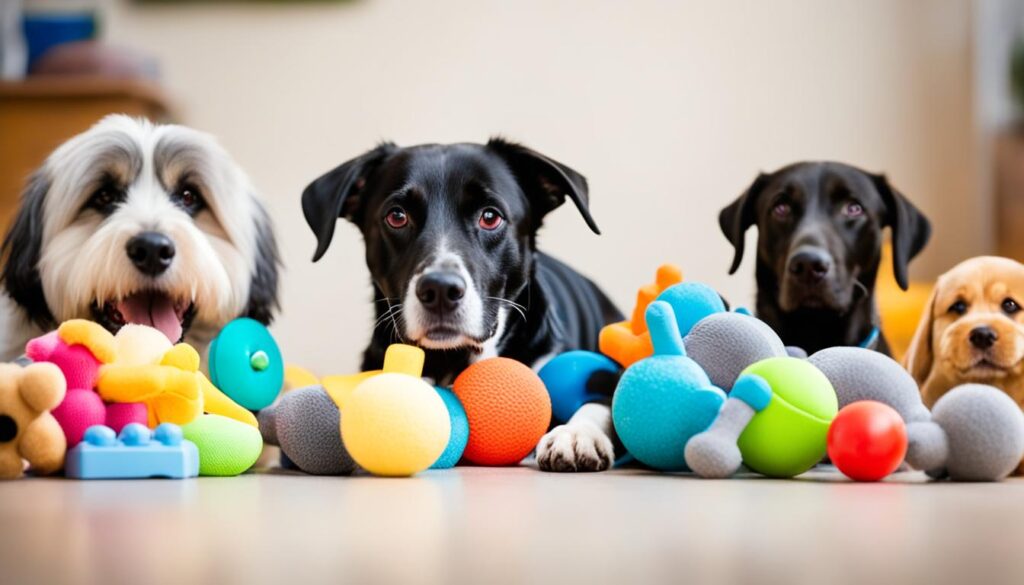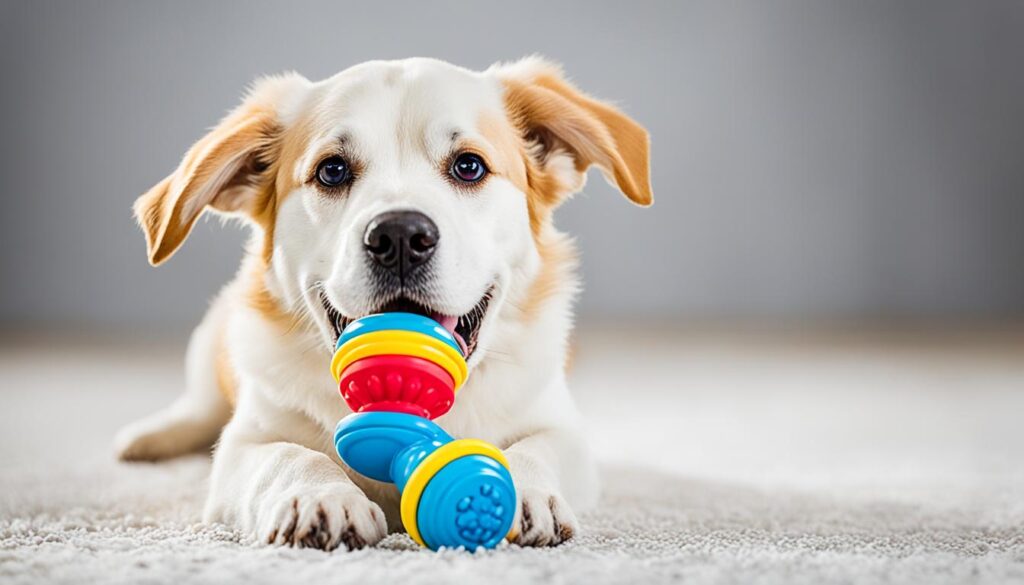Did you know that dogs have the amazing ability to understand words that correspond to their favorite toys? It’s true! Research has shown that dogs don’t just associate words with behaviors like “sit” and “stay,” but they can also understand words that are specific to their beloved toys, such as “ball” and “Frisbee”. This fascinating ability demonstrates the cognitive capabilities of dogs and hints at their understanding of language beyond basic commands.
A study conducted by researchers at Hungary’s Eötvös Loránd University delved deeper into dogs’ understanding of object word knowledge. The study involved 18 dogs from various breeds and utilized non-invasive EEG sensors to measure their brain activity. The findings of this research provide new insights into canine cognition and their ability to comprehend and respond to words related to their favorite toys.
Key Takeaways:
- Dogs can understand words that correspond to their favorite toys, demonstrating their cognitive abilities.
- Research conducted at Hungary’s Eötvös Loránd University shows that dogs exhibit neural activity that indicates their understanding of object word knowledge.
- Dogs’ ability to comprehend words beyond basic commands suggests they may understand more than they show.
- Studying dogs’ language abilities deepens our understanding of their cognitive capabilities and sheds light on the evolution of language in humans and animals.
Dogs Create Multi-Modal Mental Images of Familiar Objects
Dogs possess the remarkable ability to form multi-modal mental images of familiar objects, including their beloved toys. These mental images encompass various sensory dimensions, such as appearance and scent, enabling dogs to remember and think about objects in a comprehensive manner.
A study conducted by the Family Dog Project at Hungary’s Eötvös Loránd University sheds light on the sophisticated cognitive abilities of dogs. The research focused on how dogs discriminate between different objects and respond to human language, revealing a complex cognitive landscape.
Interestingly, some dogs, known as “Gifted Word Learners,” have displayed the ability to learn and recall the names of numerous objects. This indicates their association of verbal labels with physical items, mirroring the mental representation humans have of the world.
The study also explored the sensory integration processes in dogs’ brains. It discovered that dogs adapt their reliance on different senses based on the availability of sensory data, showcasing their flexibility in cognitive processing.
“Dogs possess a surprisingly sophisticated ability to process and interact with their environment.”
This research highlights the advanced cognitive capabilities of dogs and their ability to create multi-modal mental images of familiar objects. This complex cognitive landscape expands our understanding of canine cognition and their intricate relationship with the world around them.
Cognitive Processes in Dogs
The cognitive processes involved in dogs’ formation of multi-modal mental images are fascinating. Dogs are capable of integrating various sensory information, such as visual and olfactory cues, to create a comprehensive perception of familiar objects.
In the study conducted by the Family Dog Project, dogs exhibited a flexible cognitive process where they adjusted their sensory reliance based on the availability of sensory data. For example, in well-lit environments, dogs relied more on visual cues to locate and interact with familiar objects. However, in dark conditions, they switched to relying on olfactory cues to navigate their surroundings.
This ability to adapt and utilize different senses showcases the depth of dogs’ multi-modal sensory perception and their capacity to form complex mental representations of objects.
Understanding the World through Dogs’ Eyes
By understanding that dogs can create multi-modal mental images of familiar objects, we gain insights into their perception of the environment and how they interact with it. Dogs possess a sophisticated cognitive landscape, which allows them to navigate and comprehend the world around them.
Further research may explore how dogs apply this ability to mentally represent objects beyond their favorite toys. Investigating whether dogs can form multi-modal mental images of people, places, or other aspects of their lives would provide valuable knowledge regarding their comprehension and memory capabilities.
Dogs’ capacity to create multi-modal mental images contributes to our understanding of their cognitive abilities and how they process information, leading to enhanced communication and strengthened bond between humans and their canine companions.
| Benefits of Dogs Creating Multi-Modal Mental Images | Implications for Canine Cognition |
|---|---|
| Improved object recognition | Enhanced understanding of dogs’ cognitive processes |
| Advanced cognitive flexibility | Insights into sensory integration in dogs’ brains |
| Deeper comprehension of the world | Increased knowledge of dogs’ mental representation abilities |
Dogs Grasp the Meaning Behind Words
Research has provided evidence that dogs can grasp the meaning behind words. A study published in the journal Current Biology utilized non-invasive electroencephalogram (EEG) testing to measure the electrical pulses within the brains of 27 pet dogs during an experiment involving their owners and familiar toys.
The results showed that dogs exhibit a pattern of neural activity that indicates their ability to differentiate between words for different objects. When presented with words and objects that don’t match up, dogs show a significant signal peak in their EEG readings, suggesting their surprise at the mismatch.
This finding suggests that dogs can distinguish between the meanings of certain words, highlighting their understanding of language.
The study sheds light on canine cognition and contributes to our knowledge of the origins of complex language.

Dogs Form Complex Sensory Images of Objects
Dogs possess the remarkable ability to form complex sensory images of objects. A study conducted by the Family Dog Project at Hungary’s Eötvös Loránd University aimed to investigate the cognitive processes of typical family dogs and how they recall and search for toys using verbal cues.
The study involved a series of experiments in familiar environments, where dogs were tasked with retrieving specific toys by name. The findings revealed that dogs were able to successfully retrieve the correct toys in both well-lit and dark conditions, highlighting their reliance on multi-sensory mental representations of the objects.
In the experiment, when visual cues were available, dogs predominantly relied on visual information to locate and retrieve the toys. However, when the environment was darkened, the dogs seamlessly switched their sensory reliance to olfactory cues, harnessing their adept sense of smell to successfully find the toys. This flexible cognitive process allows dogs to adapt to different conditions and form comprehensive understandings of their environment.
“The dogs’ ability to adjust their reliance on sensory cues demonstrates the richness of their multi-modal sensory perception,” said Dr. Ádám Miklósi, the lead researcher of the study.
Through this research, we gain valuable insights into the intricate cognitive abilities of dogs. Their capacity to form detailed sensory images of objects contributes to our understanding of their remarkable perceptual skills. This understanding not only strengthens our bond with our canine companions but also sheds light on the broader field of animal cognition.
Ensuring Accurate Object Retrieval
The study also revealed that dogs were able to discriminate between toys based on verbal cues alone, demonstrating an impressive understanding of the association between words and objects. This ability suggests that dogs can create mental links between verbal labels and physical items.
Researchers discovered that dogs were more likely to retrieve the correct toy when the verbal cue was precisely aligned with the actual object. For example, if given the verbal cue “ball,” dogs would retrieve the toy that was specifically referred to as a “ball.” This finding indicates the dogs’ ability to grasp the specific meaning behind words and highlights their cognitive skills in forming accurate mental representations of objects.
Overall, dogs’ ability to form complex sensory images of objects contributes to a deeper understanding of their cognitive processes. Their adaptability, reliance on various sensory cues, and understanding of verbal associations with objects illustrate the complexity and richness of their mental capacities.

Conclusion
Dogs’ ability to understand words for their favorite toys provides fascinating insights into their cognitive abilities and communication. Research has shown that dogs can link words with specific objects and exhibit neural activity that indicates their understanding of object word knowledge.
Furthermore, dogs have the capacity to create multi-modal mental images of familiar objects, demonstrating a sophisticated ability to process and interact with their environment. This suggests that dogs have a mental representation similar to how humans think about the world.
While some dogs may refuse to fetch specific toys, this behavior is more likely driven by their desire rather than their understanding of words. Future studies may explore whether other mammals can also link words with objects and investigate dogs’ understanding of words that apply to multiple different objects.
Understanding dogs’ language abilities not only deepens our connection with our canine companions but also sheds light on the evolution of language in humans and other animals.
FAQ
How do dogs understand words for their favorite toys?
Can dogs create mental images of their favorite toys?
Do dogs grasp the meaning behind words?
How do dogs form sensory images of objects?
What insights does dogs’ word understanding provide?
Source Links
- https://www.popsci.com/environment/dogs-picture-objects-language-study/
- https://www.smithsonianmag.com/smart-news/dogs-can-understand-the-words-for-several-objects-such-as-toys-and-leashes-study-finds-180984023/
- https://www.psypost.org/how-do-dogs-think-about-their-toys-study-offers-insights-into-canine-cognition/
Amina brings over a decade of journalism experience to her role as Editor-in-Chief. Under her leadership, Exquisite Post has flourished, maintaining the highest standards of integrity and excellence. Amina’s commitment to truth and her visionary approach guide the editorial team in producing impactful news stories that resonate with our audience.










